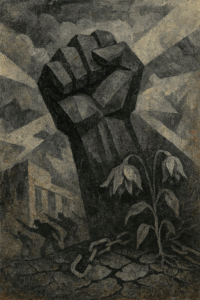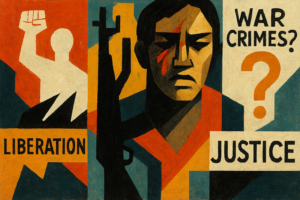
This post has already been read 12 times!
Ekushey February, a spring day in 1952 that turned bloody and entered the history books, must never be forgotten. Anyone who speaks Bengali is indebted to the day; they will remain so forever. At every turn of the history of the nation, ‘Ekushey’ has acquired a renewed significance. But occasionally I wonder whether the day has become a mere ritual? Have we separated the annual commemoration from the context within which the language movement emerged?
Important events, particularly those that change the course of history assume a life of their own as they pass through time. It is no surprise that these events are interpreted differently at different times and by different social groups. If history is about events and narratives, politics is about interpretation. None are value-free, but importantly, a key difference is the primacy of the situation in the former and the context in the latter. Situation is what influences the actions of human agent or agents working towards a goal; while the context is ‘the set of circumstances or facts that surround the particular event, situation’. In this sense context is the filter that acts as reasoning within the situation, providing meaning and interpretations to situational factors. It is the setting for the event.
In the case of the language movement, demanding the inclusion of Bengali as a state language of the newly established Pakistan and the debate surrounding this demand since 1948 was the situation that prompted the movement. Often dominant narratives of the language movement focus on the declaration of Urdu as the only state language by Muhammad Ali Jinnah on 19 March 1948 as the point of departure. We must recall that this announcement was made as a response to the official language debate at the first session of the Pakistan Legislative Assembly. On 23 February 1948 Dhirendranath Dutta, a member from East Bengal, proposed that Bangla be made one of the languages of the Assembly along with English and Urdu, a language preferred by the ruling elites. The proposal was rejected outright. In similar vein, the announcement of Khwaja Nazimuddin, then the Prime Minister, on 27 January 1952 galvanized people and served as the proximate cause of the events of 21 February.
To some it is puzzling that when educational opportunities were very limited and the rate of literacy was abysmal among the East Bengal population, a movement which apparently has little relevance had appealed to a large population. The answer to this can only be found in the context. What served as the primary context was the role of the central government during the food crisis in 1948 which contributed to the misery of the peasants and middle class. The bureaucrats and members of law enforcing agencies, especially the police emerged as the most repressive agencies of the government. These events sent a signal that the new state was as divorced from the interests of the people as the British colonial rulers had been. This apprehension was accentuated by the fact that very few Bengalis were prominent members of the new administration. Thus a clear sense of alienation from the ‘state’ was the key factor which allowed the movement to spread through the entire East Bengal population. Additionally, it was evident that the adoption of an alien language as the state language would limit the access of Bengalis to state power and hinder their economic mobility.
The rejection of Dhirendranath Dutta’s proposal in 1948 revealed two elements of the emerging Pakistani state: firstly, the utter disregard for the fundamental element of democracy – that the voice of the majority be heard; secondly, lack of recognition for the multi-ethnic nature of Pakistan. Serajul Islam Choudhury has aptly noted “the Language Movement was no accident of history. Had the explosion not come in 1952, it would have arrived later.” This is why we should emphasize the deep concordance between the social, economic, political and cultural problems of the people and the language movement of 1952.
The defining characteristic of the movement was its spontaneity. The political parties and their leaders were not at the forefront of the mobilization, neither did they foresee history in the making. This was a history made by the people. The list of the martyrs bears out the fact. Abul Barkat was a student; Rafiquddin used to work in his father’s press; Abdul Jabbar was the owner of a small shop; and Shafiqur Rahman was an employee of Dhaka High Court; Wahiullah was the son of a mason and Abdul Awal a rickshaw puller. The diary of Tajuddin Ahmed between 22nd and 25th February 1952 makes mention of spontaneous strikes of the people, in Dhaka and elsewhere in the province that was without directives from any leader or organization. Shaheed Minar was erected on the spot where students had been killed, on the night of 23 February. A then student of the Medical College – Sayeed Haider – who was the designer of this Minar, later remarked that apart from two masons, many canteen boys gave a hand to help complete its construction. They were the ones who built the memorial.
Thus we can say that Ekushey’s contexts were the alienation between the citizens and the state, denial by the state of the diversity of the citizens – ethnic and linguistic, the systemic marginalization of people, and the denial of the fundamental principle of democracy. Ekushey February in 1952 was a response to these. But they have relevance beyond 1952. The proclamation of independence of Bangladesh, as adopted on 17 April 1971, reflects the essence of these contexts and declares that the founding of the country is ‘to ensure for the people of Bangladesh equality, human dignity and social justice.’ But as we commemorate Ekushey every year, do we recollect these contexts and ask ourselves whether they still persist? Do we, as a nation, address these issues on a regular basis? Have we drifted away from the spirit of Ekushey? There is no denying that all historical events generate rituals of celebration and over time rituals become more pronounced than the contexts and essence of the event. But continuation of the only ritual for long has the potential to diminish the relevance of the events. On the other hand, underscoring the contexts, the essence and the spirit of any historical event brings relevance and contemporality to history.
Published in The Daily Star
This post has already been read 12 times!





